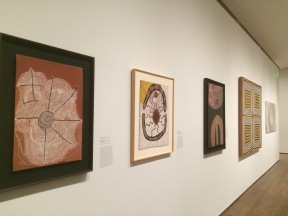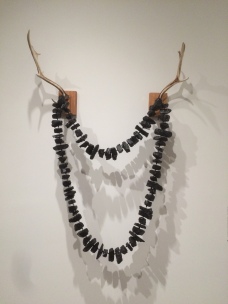
I had originally started this post as something more rigid and defined. It was a review, an art review, something I’ve really never written in my life and don’t think I’d be very good at if I tried. When I stepped away from my computer and went outside with my notebook, and really thought about how the art on display in Everywhen spoke to me, how it elicited reactions within me, I realized that there’s no point to writing a review of this exhibit, or any exhibit for that matter. Not for me, anyway. Instead, this is a reaction, from my point of view.
Everywhen: The Eternal Present in Indigenous Art from Australia, is the new exhibit at the Harvard Art Museums, and it opens to the public this Friday, February 5th. If you can, I’d suggest heading to the opening reception on Thursday evening, and you might get a chance to go to the opening lecture, a conversation between Stephen Gilchrist and artist Vernon Ah Kee. Everywhen has been guest curated for HAM by Australian Studies Visiting Curator Stephen Gilchrist, an Indigenous Australian of the Yamatji people of the Inggarda language group of Western Australia. I’ve only ever met a handful of folks from Australia in my life, and none of them had ever identified as Indigenous, so to have Stephen give this tour was a real treat; knowing that he had curated the exhibit made it even better, because he has a deep connection to the art on display.
Gilchrist spoke of ancient narratives reinterpreted in abstract concepts, of connecting the past to the present to the future in a cyclical manner (the everywhen), of reimagining your way of being in the world and considering how you interact with it. The exhibit, he says, is an invitation to question how we discuss Indigenous art in the context of contemporary art today – is it other? Do we need to redefine art history? “This is not about rescuing indigenous art,” Gilchrist says. “We are indigenizing art history.”
For me, the most important aspect of the collection represented in Everywhen was the history. If you know me, you know that generally I don’t care for contemporary art; but if it is reinterpreting history, or expressing pain or grief or demanding justice for wrongs committed in the course of so-called “enterprise”, then I’m much more intrigued and open to understanding the artist’s interpretation of their own history (the last contemporary piece I wrote about was William Kentridge’s Refusal of Time).
 History cannot be separated from art, nor should it be. The Indigenous artworks on display in Everywhen are personal reactions to the events of the past; attempts to cross the divide between the present and what once way, spanning almost 40,000 years of history. Julie Gough’s piece Dark Valley, Van Diemen’s Land (2008) (at right) connects the artist, born in Tasmania and part of the Trawlwoolway language group, to her ancestor’s tradition of creating necklaces out of shells, reflecting the maritime culture of her people. The large chunks of coal tell the tale of Aboriginal exile and extermination, in the name of economy and progress; the story of The Black War hangs in the gallery, bringing back the voices of thousands of innocent victims slain in the name of industry.
History cannot be separated from art, nor should it be. The Indigenous artworks on display in Everywhen are personal reactions to the events of the past; attempts to cross the divide between the present and what once way, spanning almost 40,000 years of history. Julie Gough’s piece Dark Valley, Van Diemen’s Land (2008) (at right) connects the artist, born in Tasmania and part of the Trawlwoolway language group, to her ancestor’s tradition of creating necklaces out of shells, reflecting the maritime culture of her people. The large chunks of coal tell the tale of Aboriginal exile and extermination, in the name of economy and progress; the story of The Black War hangs in the gallery, bringing back the voices of thousands of innocent victims slain in the name of industry.
 Yhonnie Scarce’s The silence of others (series of six) (2014) (at left) is another piece that throws history in the viewer’s face, demanding to be remembered. Scarce uses yams as the shape of her blown glass trapped under bell jars. Each piece engraved with an archival number that represents one of her immediate family members; each of them treated as inhuman and “other” by having their body parts measured and catalogued as a taxonomical specimen (sound familiar?). The yams are representative of the Indigenous peoples’ affinity and connection with the natural world, and an attempt to remind us of the strength of that connection, as it flies in the face of colonization and Western “progress”.
Yhonnie Scarce’s The silence of others (series of six) (2014) (at left) is another piece that throws history in the viewer’s face, demanding to be remembered. Scarce uses yams as the shape of her blown glass trapped under bell jars. Each piece engraved with an archival number that represents one of her immediate family members; each of them treated as inhuman and “other” by having their body parts measured and catalogued as a taxonomical specimen (sound familiar?). The yams are representative of the Indigenous peoples’ affinity and connection with the natural world, and an attempt to remind us of the strength of that connection, as it flies in the face of colonization and Western “progress”.
It’s important to recognize that this is the first exhibition of its kind in the United States in 25 years. Narayan Khandekar of the Straus Center for Conservation pointed out to us in the gallery, as we looked at a bark painting by Manydjarri Ganambar, that up until recently there had been no technical studies of the materials used to create bark paintings. Narayan worked with art galleries and museums in Australia to study 200 samples of pigments and bark types to learn more about how contemporary Indigenous artists are using materials to connect with their ancestors and the past.
As a student of history, I think everyone should come to this exhibit and take the time to consider similar events that occurred in our own country’s history. Every piece on display in Everywhen tells a story; every brush stroke, every weave is entrenched in the history and ancestral narrative of the Indigenous peoples of Australia. The exhibition is an amazing opportunity to learn about the culture and history of a population I know very little about, and I recommend you visit often. I know I will.
Thanks to Becca Torres at the Harvard Art Museums for giving me the opportunity to join the press preview of Everywhen, and thank you to Stephen Gilchirst (Australian Studies Visiting Curator) and Narayan Khandekar (Director, Straus Center for Conservation and Technical Studies) for the tour of the gallery and the insights into the historical and technical aspects of working with the collection. Everywhen: The Eternal Present in Indigenous Art from Australia is on display at the Harvard Art Museums until September 18, 2016.